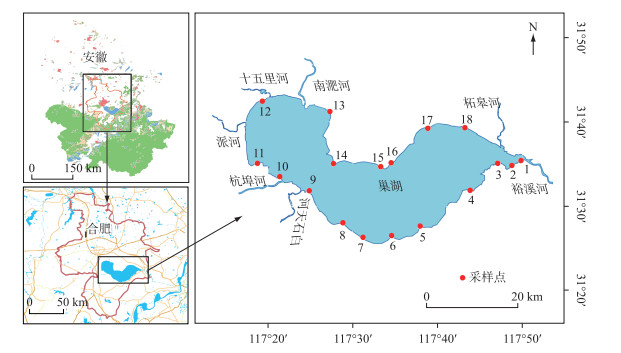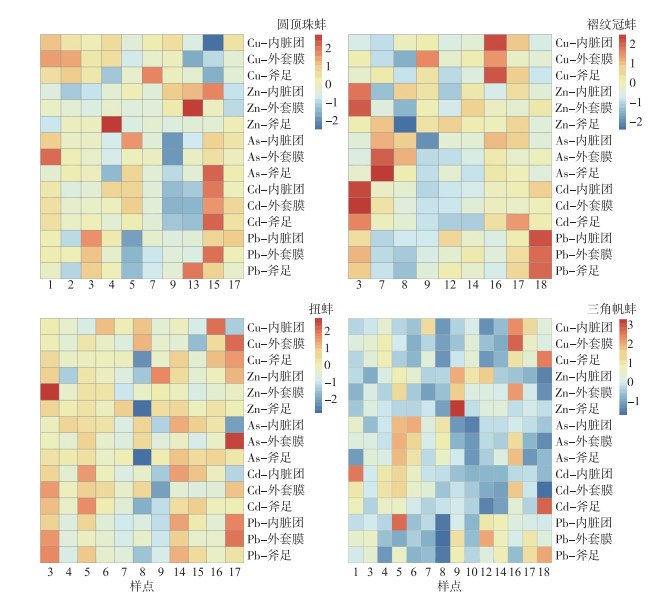(2: 安徽省湿地保护与修复重点实验室, 合肥 230601)
(2: Key Laboratory of Wetland Protection and Restoration of Anhui Province, Hefei 230601, P. R. China)
随着我国工农业迅速发展和城市化进程的不断推进,工业废水、农业排水以及城市生活污水等的排放日益增加,重金属及类重金属等不断进入水体,日益成为水环境中的主要污染物[1].重金属是高毒性污染物,当被泄露到水体后,会抑制酶的活性,抑制水生植物的光合作用和呼吸作用,同时无法被水中微生物正常降解,也不能借助水体自净作用进行消除[2].重金属容易随着食物链放大与传递,在水生生物体内不断富集[3],因此水体重金属污染往往会对水生动物产生严重影响.
蚌类隶属软体动物门(Mollusca),营底栖生活,广泛分布于湖泊、河流、沟渠等水域,是蛋白质、必需脂肪酸、六味精和矿物质的重要来源之一[4].在水生生态系统中,蚌类作为食物链中的初级消费者,既是藻类等初级生产者的滤食者,也是鱼、蟹等高级消费者的食物,在食物链中起着承上启下的作用,因此蚌类首当其冲地受到水体中重金属污染的危害.由于重金属能够与短碳链结合,水体中重金属极易在蚌体组织中积聚[5],重金属在蚌体内会与巯基蛋白结合,改变蛋白质构象,其生物毒性及危险性不容小觑[6-7].目前关于蚌体重金属及类重金属的研究国内外已有不少报道,Bustamante等[8]调查并分析了法国比斯开湾扇贝(Chlamys varia)中17种元素的分布规律,陈修报等[9]通过背角无齿蚌(Anodonta woodiana)对五里湖重金属含量进行监测与评价,程家丽等[10]对我国多个地区海洋食用贝类重金属污染的分析发现,海洋贝类重金属复合污染的健康风险较高,然而针对不同蚌类重金属含量的对比和淡水湖泊中筛选耐受性物种的研究还较少.
巢湖(31°25′~31°43′N,117°16′~117°50′E),长江水系下游湖泊,位于安徽省中部,是中国五大淡水湖之一[11].近三十年来,随着巢湖周边的开发与工业化的发展,加之湖水主要靠地表径流补给,大量含有微量元素的废弃物随地表河流聚集到巢湖[12],致使巢湖水环境和沉积物中的重金属逐步累积,另外土壤改良剂和肥料的不断施用也会加剧这一农业集约化区域的重金属积累[13],最终经由食物链和食物网富集到水生生物体内.目前对于巢湖重金属方面的研究主要集中于巢湖水体及沉积物重金属的分布、形态及来源[14-16]和鱼类虾类的重金属污染以及食用风险方面[17]等.本研究以生活于巢湖中的扭蚌(Arconaia lanceolata)、三角帆蚌(Hyriopsis cumingii)、褶纹冠蚌(Cristaria plicata)和圆顶珠蚌(Unio douglasiae)为对象,分析了其内脏团、外套膜(包含鳃)和斧足中重金属(Cu、Zn、Pb、Cd)和类重金属(As)的含量,并初步评价了4种蚌的食用风险,以期为淡水湖泊生态修复中耐受性物种的选择提供依据.
1 材料与方法 1.1 样品的采集与预处理于2017年6月,在综合考虑巢湖入湖河流分布、样点可取性、人类干扰程度等因素的前提下,借助GPS全球卫星定位系统,在巢湖布设18个采样点(图 1),各采样点相距岸线约200~500 m,采集的扭蚌(共49个)、三角帆蚌(共46个)、褶纹冠蚌(共45个)和圆顶珠蚌(共39个)活蚌体(均为成年蚌)现场清洗掉淤泥(蚌体基础数据见表 1),并用洁净的聚乙烯自封袋封存于4℃的保温盒,带回实验室后取出内脏团、外套膜(包含鳃,下同)和斧足等组织,后经称重(鲜重)、匀浆、冷冻干燥后研磨成粉备用[18].

|
图 1 巢湖采样点分布 Fig.1 Distribution of sampling sites in Lake Chaohu |
| 表 1 巢湖所采集的4种蚌类的基础数据* Tab. 1 Basic data for four species of mussels in Lake Chaohu |
取样品0.2 g(精确到0.001 g)于聚四氟乙烯消解内罐中,加入7 mL浓硝酸和1 mL 30 %过氧化氢,旋紧内盖静置过夜,按照GB 5009.268-2016《食品安全国家标准食品中多元素的测定》中的消解条件进行微波消解,冷却后取出,用少量去离子水冲洗内盖,于超声水浴箱中超声脱气5分钟,最后用去离子水将消解液定容至50 mL并混匀[19].采用电感耦合等离子体质谱法(ICP-MS)以元素质荷比(m/z)定性、外标法定量,以Ge、Rh、Re为内标元素同时测定Cu、Zn、Pb、As、Cd等微量元素.为检验测定的准确性,采用扇贝成分标准物质(GBW10024)进行质量控制,其回收率均在90 % ~110 %之间.为提高精确度和减小随机误差,所有样品分析均重复进行3次(取其平均值).
1.3 数据处理方法采用WPS Excel 2010和SPSS 23.0软件对数据结果进行统计与处理.试验数据结果表示为平均值±标准差,进行Student-Newman-Keuls检验,显著性水平P < 0.05.执行R 3.5.1软件中Pheatmap包进行热图绘制(绘图前对数据进行标准化).
2 结果与分析 2.1 4种蚌类不同组织中的微量元素含量在巢湖18个样点所采集的4种蚌类中各微量元素均有检出.各蚌体不同组织中的重金属及类重金属含量(干重,dw)见表 2.
| 表 2 巢湖4种蚌类不同组织中微量元素含量(μg/g(dw))* Tab. 2 Trace elements content in different tissues of four species of mussels in Lake Chaohu |
除Zn在圆顶珠蚌组织间含量趋势为外套膜 > 内脏团 > 斧足外,巢湖4种蚌体中5种微量元素含量在组织间的差异均表现为内脏团 > 外套膜 > 斧足.内脏团中Cu、Zn、As、Cd、Pb含量的变化范围分别为6.86~10.10、105.48~151.79、3.96~6.57、0.51~3.18、1.02~7.13 μg/g(dw),圆顶珠蚌与三角帆蚌之间以及扭蚌与褶纹冠蚌之间Cu的含量差异不显著(P > 0.05),但这两组之间有明显差异(P < 0.05);外套膜中Cu、Zn、As、Cd、Pb 5种元素的变化范围分别为4.28~4.77、89.83~196.83、2.32~4.21、0.40~2.76、0.99~5.62 μg/g(dw),4种蚌类中Cu和As的含量没有显著性差异(P > 0.05);斧足中各元素的含量范围分别为2.55~3.49、80.34~95.23、1.97~3.06、0.08~0.71、0.86~2.93 μg/g(dw),斧足中Cu、Zn、As和Cd含量均无显著性差异(P > 0.05). 5种微量元素在4种蚌类中的平均含量均表现为Zn > Cu > As > Pb > Cd.
4种蚌类中5种微量元素平均含量高低各有差异. Cu和Pb在4种蚌类中的平均含量表现为扭蚌 > 褶纹冠蚌 > 圆顶珠蚌 > 三角帆蚌,Pb在扭蚌各组织中的含量均最高,内脏团、外套膜、斧足中Pb含量分别是其他3种蚌类的5.65~6.99倍、4.46~5.68倍、2.62~3.41倍;Zn的各平均含量表现为圆顶珠蚌 > 扭蚌 > 三角帆蚌 > 褶纹冠蚌,Zn在圆顶珠蚌中含量最高,是其他3种蚌类的1.41~2.11倍;Cd含量表现为扭蚌 > 圆顶珠蚌 > 三角帆蚌 > 褶纹冠蚌,Cd在圆顶珠蚌和扭蚌中的含量是三角帆蚌和褶纹冠蚌的2.75~6.08倍;As在4种蚌类中的平均含量表现为圆顶珠蚌 > 三角帆蚌 > 褶纹冠蚌 > 扭蚌.
2.2 4种蚌类在不同样点的微量元素含量4种蚌类在不同样点间的微量元素含量高低趋势见图 2.三角帆蚌各个组织的5种微量元素含量较其他3种蚌类均最低,圆顶珠蚌的各组织在15号点的Cd含量均较其他样点高,褶纹冠蚌在3号点的Zn和Cd含量、7号点的As含量、16号点的Cu含量、18号点的Pb含量较高,扭蚌各样点的微量元素中,3号和5号样点的Cd含量略高,17号样点的As含量、Pb含量、Cu含量和3号样点的Zn含量在外套膜中均较高.

|
图 2 4种蚌类不同样点的微量元素含量分布热图 Fig.2 Heat map of trace elements content in different sites of four species of mussels |
通过对同时采集到4种蚌类的3、7、9和17号样点进行不同种类、样点对各微量元素含量影响的方差分析结果(表 3)可知,在P < 0.05的显著水平下,Cu和As在不同种类和样点间的含量均无显著性差异,Zn和Cd趋势一致,在种类间有显著性差异,在样点间差异不显著,并且Cd在种类间的差异极显著(P < 0.01),Pb在种类和样点间差异均显著,并且在种类间的差异极显著(P < 0.01).由此可知,不同种类之间微量元素含量的差异大于同一种类微量元素含量的空间差异.
| 表 3 不同种类、样点对各微量元素含量影响的方差分析结果* Tab. 3 Variance analysis results of different species of mussels and sample sites on the content of trace elements |
4种蚌体各组织对各微量元素的富集具有明显选择性,除圆顶珠蚌中Zn元素在组织间含量趋势为外套膜 > 内脏团 > 斧足外,巢湖4种蚌体中5种微量元素含量趋势均为内脏团 > 外套膜 > 斧足,这与学者们[20-21]的研究结果一致.内脏团中的肝胰脏是对外源污染物进行代谢的重要器官,重金属及类重金属等污染物通过消化道后,最终体内运输到肝胰脏参与代谢并大量蓄积[22].蚌类中各微量元素含量变化表现出组织特异性[23],这可能与蚌体组织间金属硫蛋白含量的差异[24]有关.
本研究中不同蚌类对同一元素的富集能力存在明显差异,这与庞艳华等[25]的研究结果一致.在毕士川等[26]对上海市场不同水产品中Pb含量的调查结果中,未发现有对Pb特别富集的品种,不同科间Pb含量没有明显差异,而本研究通过表 2发现,扭蚌各组织中Pb含量均最高,通过对比不同蚌类中Pb含量发现,即便是扭蚌含量最低的斧足中的含量也高于其他蚌类含量最高的内脏团中的含量,说明扭蚌对Pb的富集程度相比于其他3种蚌类是最高的,与其他3种存在显著差异(P < 0.05).赵卫红等[27]研究发现微黄镰玉螺中Pb通过渗透作用进入体内,而扁玉螺中Pb则是通过呼吸作用进入体内,由此认为不同贝类对同种重金属的富集机制不同.霍礼辉等[28]在探究重金属对贝类金属硫蛋白的诱导作用时也表明不同金属的亲和能力不同,双壳贝类对Pb的浓集系数较高,并且与种类及组织器官功能的差异相关.本研究中扭蚌体内较高的Pb含量也可能是由于扭蚌对Pb的富集机制以及Pb对扭蚌体内金属硫蛋白的诱导作用不同于其他3种蚌类导致的.
通过对比前人对巢湖各河口沉积物[29]、水体[30]重金属研究的数据发现,在重金属及类重金属污染最重的南淝河河口附近的13号点仅采集到圆顶珠蚌,可能是因为水体重度污染不利于蚌体存活,并且蚌体内Zn、Pb含量均较高,在派河、裕溪河、白石天河等污染程度依次减弱的河口采集到的蚌体内各微量元素含量也呈现递减趋势.在裕溪河、柘皋河、十五里河、白石天河、杭埠河等污染程度总体呈现出依次减弱的河口,褶纹冠蚌、扭蚌和三角帆蚌中各微量元素含量也呈现出逐渐降低趋势,表明不同样点间的蚌体内微量元素含量高低与沉积物及水环境中微量元素含量在空间上的高低趋势一致,可能是因为蚌体多从水中浮游植物以及沉积物中通过食物摄取微量元素[31],因此蚌类可作为指示生物,监测水生生态系统微量元素含量变化,这种生物监测相比于直接通过水或沉积物检测,更具经济效益,规避了通过水及沉积物检测过程中波动大、含量低、反应不及时等问题[32].蚌体内的微量元素富集同时受生物因子(如年龄、种类、性别、食物种类等)[33-34]和非生物因子(如温度、pH、盐度等)[35-36]影响.本研究中,蚌体微量元素含量的种间差异大于同一种类微量元素含量的空间差异(表 3),元素Cd、Pb的种间差异均表现为差异极显著(P < 0.01),然而因样品量不足的限制,试验中未考虑蚌体年龄差异、性别等的影响,后续仍需进一步研究.
蚌类中绝大部分可食用,随着社会发展和人类需求的增加,蚌体养殖及捕捞日益普遍,使得蚌类成为常见的水产品之一[37].根据GB 2762—2017《食品安全国家标准食品中污染物限量》中规定的水产品可食用部分污染物限量标准(湿重,ww),Pb≤1.5 mg/kg、Cd≤2.0 mg/kg(去除内脏)、无机砷(As)≤0.5 mg/kg(总砷含量无限定标准),据表 4可知,本研究中4种蚌类Pb和Cd的含量均未超标,总As含量均超出无机砷限量标准,然而无机As占总As含量的2 % [38]~42 % [39],据此比例,四种蚌类无机砷含量均未超标,但三角帆蚌和圆顶珠蚌中As含量相对较高,无机砷最大值可能达到0.36~0.37 mg/kg,考虑到As在人体内不易代谢,容易造成蓄积,可能会导致人体内As含量超出限量标准,因此不建议大量食用.
| 表 4 巢湖4种蚌类微量元素含量(mg/kg(ww))* Tab. 4 Trace elements content in four species of mussels in Lake Chaohu |
1) 巢湖4种常见蚌类对As、Cu、Cd、Pb、Zn 5种微量元素均有不同程度的富集,4种蚌体组织间各元素平均含量(除圆顶珠蚌中Zn外)均表现为内脏团 > 外套膜 > 斧足,圆顶珠蚌中Zn的平均含量则表现为外套膜 > 内脏团 > 斧足.
2) 4种蚌类各微量元素平均含量均表现为Zn > Cu > As > Pb > Cd,扭蚌对Cd和Pb有较高的积累,其含量为其他3种蚌类的6~7倍,圆顶珠蚌对Zn的富集程度最高.
3) 蚌体在污染较严重的河口中各微量元素含量较高,且蚌体微量元素含量的种间差异大于同一种类微量元素含量的空间差异.
4) 巢湖蚌体内Pb和Cd含量均符合食品安全国家标准的限定标准,无机As含量也在安全范围内,但三角帆蚌和圆顶珠蚌中不排除因As蓄积而存在的安全风险,不建议大量食用.
| [1] |
Diao WP, Ni WZ, Ni TH et al. Status and evaluation of heavy metal pollution in water environment. Guangdong Trace Element Science, 2004, 11(3): 1-5. [刁维萍, 倪吾钟, 倪天华等. 水环境重金属污染的现状及其评价. 广东微量元素科学, 2004, 11(3): 1-5.] |
| [2] |
Zhang JT, Liu JL. Harm of heavy metal pollution in water body and its treatment. Shandong Industrial Technology, 2019, 286(8): 41. [张家铜, 刘佳麟. 水体重金属污染的危害及其治理. 山东工业技术, 2019, 286(8): 41.] |
| [3] |
Li J, Huang ZY, Hu Y et al. Potential risk assessment of heavy metals by consuming shellfish collected from Xiamen, China. Environmental Science and Pollution Research, 2013, 20(5): 2937-2947. DOI:10.1007/s11356-012-1207-3 |
| [4] |
Zhelyazkov G, Yankovska-Stefanova T, Mineva E et al. Risk assessment of some heavy metals in mussels (Mytilus galloprovincialis) and veined Rapa whelks (Rapana venosa) for human health. Marine Pollution Bulletin, 2018, 128: 197-201. DOI:10.1016/j.marpolbul.2018.01.024 |
| [5] |
Jitar O, Teodosiu C, Oros A et al. Bioaccumulation of heavy metals in marine organisms from the Romanian sector of the Black Sea. New Biotechnology, 2015, 32(3): 369-378. DOI:10.1016/j.nbt.2014.11.004 |
| [6] |
Jović M, Stanković S. Human exposure to trace metals and possible public health risks via consumption of mussels Mytilus galloprovincialis from the Adriatic coastal area. Food and Chemical Toxicology, 2014, 70: 241-251. DOI:10.1016/j.fct.2014.05.012 |
| [7] |
Sokolova IM, Lannig G. Interactive effects of metal pollution and temperature on metabolism in aquatic ectotherms: Implications of global climate change. Climate Research, 2008, 37(2/3): 181-201. |
| [8] |
Bustamante P, Miramand P. Subcellular and body distributions of 17 trace elements in the variegated scallop Chlamys varia from the French Coast of the Bay of Biscay. Science of the Total Environment, 2005, 337(1/2/3): 59-73. DOI:10.1016/j.scitotenv.2004.07.004 |
| [9] |
Chen XB, Su YP, Liu HB et al. Active biomonitoring of heavy metal pollution level of Wulihu area, Lake Taihu using "standardized" Anodonta woodiana. J Lake Sci, 2014, 26(6): 857-863. [陈修报, 苏彦平, 刘洪波等. 基于"标准化"背角无齿蚌(Anodonta woodiana)对太湖五里湖重金属污染的主动监测. 湖泊科学, 2014, 26(6): 857-863. DOI:10.18307/2014.0607] |
| [10] |
Cheng JL, Zhang XH, Zhuo Q et al. Accumulation and health risks of heavy metals in edible marine shellfishes from China. Chinese Journal of Food Hygiene, 2016, 28(2): 175-181. [程家丽, 张贤辉, 卓勤等. 我国海洋食用贝类重金属污染特征及其健康风险. 中国食品卫生杂志, 2016, 28(2): 175-181.] |
| [11] |
Zhang M, Kong FX. The process, spatial and temporal distributions and mitigation strategies of the eutrophication of Lake Chaohu (1984-2013). J Lake Sci, 2015, 27(5): 791-798. [张民, 孔繁翔. 巢湖富营养化的历程、空间分布与治理策略(1984-2013年). 湖泊科学, 2015, 27(5): 791-798. DOI:10.18307/2015.0505] |
| [12] |
Dong WT, Cheng XF. Research review on non-point source pollution in Chaohu basin. Environmental Science and Management, 2011, 36(8): 46-49. [董文涛, 程先富. 巢湖流域非点源污染研究综述. 环境科学与管理, 2011, 36(8): 46-49.] |
| [13] |
Tang WZ, Shan BQ, Zhang H et al. Heavy metal sources and associated risk in response to agricultural intensification in the estuarine sediments of Lake Chaohu Valley, East China. Journal of Hazardous Materials, 2010, 176(1/2/3): 945-951. |
| [14] |
Tong JH, Huang XM, Chen Y. Evaluation of heavy metal pollution in Lake Chaohu. Anhui Agricultural Science, 2006, 34(17): 4373-4374. [童军华, 黄祥明, 陈勇. 巢湖水体重金属污染评价. 安徽农业科学, 2006, 34(17): 4373-4374.] |
| [15] |
Liu X, Jiang Y, Gao JF et al. Pollution characteristics of heavy metals and the risk assessment for the surface sediments from Lake Chaohu and its main tributary rivers. J Lake Sci, 2016, 28(3): 502-512. [刘新, 蒋豫, 高俊峰等. 巢湖湖区及主要出入湖河流表层沉积物重金属污染特征及风险评价. 湖泊科学, 2016, 28(3): 502-512. DOI:10.18307/2016.0305] |
| [16] |
Kong M, Dong ZL, Chao JY et al. Bioavailability and ecological risk assessment of heavy metals in surface sediments of Lake Chaohu. China Environmental Science, 2015, 35(4): 1223-1229. [孔明, 董增林, 晁建颖等. 巢湖表层沉积物重金属生物有效性与生态风险评价. 中国环境科学, 2015, 35(4): 1223-1229.] |
| [17] |
Bao FY, Xiao YY, Xiao MS et al. Determination and evaluation of heavy metal of aquatic animals in Lake Chaohu. Modern Agricultural Sciences and Technology, 2016(8): 263-264, 266. [鲍方印, 肖月阳, 肖明松等. 巢湖水产品体内重金属含量测定与评价. 现代农业科技, 2016(8): 263-264, 266.] |
| [18] |
Apeti DA, Lauenstein GG, Evans DW. Recent status of total mercury and methyl mercury in the coastal waters of the northern Gulf of Mexico using oysters and sediments from NOAA's mussel watch program. Marine Pollution Bulletin, 2012, 64(11): 2399-2408. DOI:10.1016/j.marpolbul.2012.08.006 |
| [19] |
Duan YH, Ning JS, Zhai YX et al. Effect of different digestion methods on the determination of inorganic elements in aquatic products by inductively coupled plasma mass spectrometry. Journal of Food Safety & Quality, 2015, 6(12): 4916-4923. [段元慧, 宁劲松, 翟毓秀等. 不同消解方式对电感耦合等离子体质谱法测定水产品中无机元素的影响. 食品安全质量检测学报, 2015, 6(12): 4916-4923.] |
| [20] |
Sun WP, Pan JM, Liu XY et al. Study of the content of heavy metals in the mollusks from the near-shore of Zhejiang Province. Journal of Marine Science, 2010, 28(4): 43-49. [孙维萍, 潘建明, 刘小涯等. 浙江沿海贝类体内重金属元素含量水平与评价. 海洋学研究, 2010, 28(4): 43-49.] |
| [21] |
Lin YJ, Jian L, Kou YQ et al. Survey of heavy metal bioaccumulation of bivalve seashell in off-shore area of Dongzhai harbor. Environmental Science and Technology, 2018, 41(8): 17-23. [林艺佳, 蹇丽, 寇彦巧等. 东寨港近岸底栖贝类重金属的富集特征研究. 环境科学与技术, 2018, 41(8): 17-23.] |
| [22] |
Dsikowitzky L, Mengesha M, Dadebo E et al. Assessment of heavy metals in water samples and tissues of edible fish species from Awassa and Koka Rift Valley Lakes, Ethiopia. Environmental Monitoring and Assessment, 2013, 185(4): 3117-3131. DOI:10.1007/s10661-012-2777-8 |
| [23] |
Inza B, Ribeyre F, Maury-Brachet R et al. Tissue distribution of inorganic mercury, methylmercury and cadmium in the Asiatic clam (Corbicula fluminea) in relation to the contamination levels of the water column and sediment. Chemosphere, 1997, 35(12): 2817-2836. DOI:10.1016/s0045-6535(97)00342-1 |
| [24] |
Wang HL, Tao S. Application of biomarkers in aquatic environmental research. China Environmental Science, 1999, 19(5): 421-426. [王海黎, 陶澍. 生物标志物在水环境研究中的应用. 中国环境科学, 1999, 19(5): 421-426.] |
| [25] |
Pang YH, Sui K, Wang QY et al. Investigation and assessment on heavy metals in bivalve seashells of Dalian coastline. Marine Environmental Science, 2012, 31(3): 410-413. [庞艳华, 隋凯, 王秋艳等. 大连近岸海域双壳贝类重金属污染调查与评价. 海洋环境科学, 2012, 31(3): 410-413.] |
| [26] |
Bi SC, Yu HJ, Cai YL et al. The content and pollution evaluation of heavy metal Pb in different aquatic products. Environmental Science and Technology, 2007, 30(1): 79-81, 124. [毕士川, 于慧娟, 蔡友琼等. 重金属Pb在不同水产品中的含量及污染状况评价. 环境科学与技术, 2007, 30(1): 79-81, 124.] |
| [26] |
Bi SC, Yu HJ, Cai YQ et al. Contents and pollution of Pb in various fisheries. Environmental Science and Technology, 2007, 30(1): 73-75. [毕士川, 于慧娟, 蔡友琼等. 重金属Pb在不同水产品中的含量及污染状况评价. 环境科学与技术, 2007, 30(1): 73-75.] |
| [27] |
Zhao WH, Chen XG, Fei ZH et al. Preliminary study on ability of accumulation of heavy metal in different Mollusca and their different tissues and organs from Yancheng seashore bottomland. Journal of Shanghai Jiao Tong University:Agricultural Science, 2009, 27(1): 76-78, 85. [赵卫红, 陈献稿, 费正皓等. 盐城滩涂贝类及其不同组织器官对重金属富集能力的初步研究. 上海交通大学学报:农业科学版, 2009, 27(1): 76-78, 85.] |
| [28] |
Huo LH, Lin ZH, Bao YB. Research progress of heavy metal-induced shellfish metallothionein. Journal of Hydrology, 2011, 32(1): 7-13. [霍礼辉, 林志华, 包永波. 重金属诱导贝类金属硫蛋白研究进展. 水生态学杂志, 2011, 32(1): 7-13.] |
| [29] |
Shi ZF, Jiang X, Yang SW et al. The spatial and temporal variation characteristics and potential ecological risk assessment of heavy metal pollution in surface sediments of Chaohu, China. Journal of Agro-Environment Science, 2010, 29(5): 948-954. [石志芳, 姜霞, 杨苏文等. 巢湖表层沉积物中重金属污染的时空变化特征及潜在生态风险评价. 农业环境科学学报, 2010, 29(5): 948-954.] |
| [30] |
Li GL, Liu GJ, Jiang MM et al. Partition characteristics and correlation of heavy metal between sediment and surface water from Lake Chaohu. Journal of University of Science and Technology of China, 2011, 41(1): 9-15. [李国莲, 刘桂建, 姜萌萌等. 巢湖表层沉积物与上覆水体中重金属分配特征及其相关性研究. 中国科学技术大学学报, 2011, 41(1): 9-15.] |
| [31] |
Spada L, Annicchiarico C, Cardellicchio N et al. Heavy metals monitoring in mussels Mytilus galloprovincialis from the Apulian coasts (Southern Italy). Mediterranean Marine Science, 2013, 14(1): 99. DOI:10.12681/mms.323 |
| [32] |
Rainbow PS. Biomonitoring of heavy metal availability in the marine environment. Environmental Pollution, 1996, 94(2): 244. DOI:10.1016/s0269-7491(97)84230-3 |
| [33] |
Al-Farsi AH, Sulaiman H, Al-Reasi HA. Metal transfer from marine coastal sediment to food chain: Evaluating Strombus (Conomurex) persicus for monitoring metal bioaccumulation. Procedia Environmental Sciences, 2015, 28: 37-44. DOI:10.1016/j.proenv.2015.07.006 |
| [34] |
Youssef M. Heavy metals contamination and distribution of benthic foraminifera from the Red Sea coastal area, Jeddah, Saudi Arabia. Oceanologia, 2015, 57(3): 236-250. DOI:10.1016/j.oceano.2015.04.002 |
| [35] |
Mubiana VK, Blust R. Effects of temperature on scope for growth and accumulation of Cd, Co, Cu and Pb by the marine bivalve Mytilus edulis. Marine Environmental Research, 2007, 63(3): 219-235. DOI:10.1016/j.marenvres.2006.08.005 |
| [36] |
Raissy M, Rahimi E, Nadeali V et al. Mercury and arsenic in green tiger shrimp from the Persian Gulf. Toxicology and Industrial Health, 2014, 30(3): 206-210. DOI:10.1177/0748233712452608 |
| [37] |
Xue TT, Liu XJ, WU RW et al. Standing stock and spatial distribution pattern of unionids in Lake Taihu, China. J Lake Sci, 2019, 31(1): 204-212. [薛涛涛, 刘雄军, 武瑞文等. 太湖蚌类现存量及空间分布格局. 湖泊科学, 2019, 31(1): 204-212. DOI:10.18307/2019.0119] |
| [38] |
Li XJ, Tang XZ. Risk assessment of arsenic pollution in aquatic product. Modern Agricultural Sciences, 2009, 16(3): 149-151. [李孝军, 唐行忠. 水产品中砷污染的风险评估. 现代农业科学, 2009, 16(3): 149-151.] |
| [39] |
Sloth JJ, Julshamn K. Survey of total and inorganic arsenic content in blue mussels (Mytilus edulis L.) from Norwegian fiords: Revelation of unusual high levels of inorganic arsenic. Journal of Agricultural and Food Chemistry, 2008, 56(4): 1269-1273. DOI:10.1021/jf073174+ |
 2020, Vol. 32
2020, Vol. 32 


